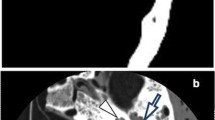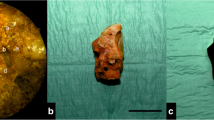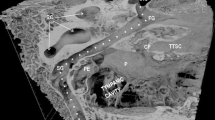Abstract
Ten cadaver temporal bone blocks were studied with high-resolution computed tomography (HRCT) in order to produce topographic images, which are more informative than ordinary CT slices. Virtual endoscopic images were produced with separate, commercially available software, paying attention to the middle ear cavity and ossicles. Four major viewing locations for virtual endoscopy (the ear canal, hypotympanum, attic and eustachian tube) developed images acceptably. The malleus and incus were visualized properly. Small structures such as the lenticular process and the stapes sometimes failed to have good imaging. The eustachian tube and attic virtual views, which are usually not receptive to ordinary endoscopy, gave proper visualization of middle ear structures. Even the smallest structure, the stapes, can produce a virtual image.Virtual endoscopic images, or topographic images, of the middle ear and ossicles contribute to the understanding of the anatomy of the middle ear, thus enhancing the chances for successful surgery.
Similar content being viewed by others
Author information
Authors and Affiliations
Additional information
Received: 2 January 2001 / Accepted: 9 July 2001
Rights and permissions
About this article
Cite this article
Karhuketo, T., Dastidar, P., Ryymin, P. et al. Virtual endoscopy imaging of the middle ear cavity and ossicles. Eur Arch Otorhinolaryngol 259, 77–83 (2002). https://doi.org/10.1007/s004050100410
Published:
Issue Date:
DOI: https://doi.org/10.1007/s004050100410




